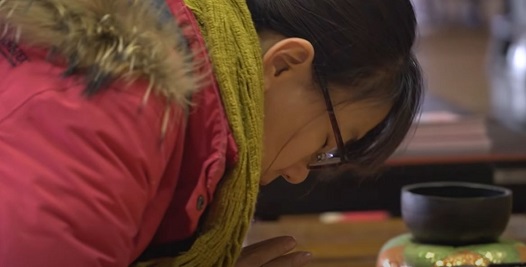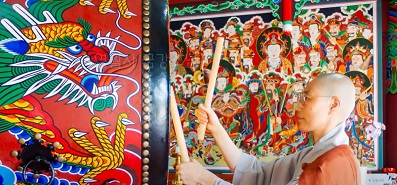
唵 阿嚕勒繼 娑婆訶
ǎn ālǔlēijì suōpóhē
옴 아로륵계 사바하
om a-ro-reuk-gye sabaha
おん あろりきゃ そわか
on arorikya sowaka
ओं आरोलिक् स्वाहा
oṃ ālolik svāhā
Category: korean buddhism
“Paradise and Amita Buddha with his forty-eight vows really do exist”, Sosan Taesa
So we can see from all of this that the teachings can freely use
seemingly different expedient means and expressions to point to the
same universal substance. Only the words themselves have a
different appearance and meaning, yet the point they communicate
is the same. For one whose insight is in accord with his actions, it is
possible to see through what is said to be “near” or “far.” This is why
our tradition can embrace both ways of practice: calling out to Amita
Buddha, like Hui-yuan, and looking directly into true nature, like
Jui-yen.
Xuanzang’s Heart Sutra in Mandarin, Vietnamese, Japanese, and Korean
Buddhists throughout East Asia chant the version of the Heart Sutra that goes back to the legendary translator Xuanzang, who lived about 14 hundred years ago. That is to say, Buddhists in China, Vietnam, Japan, and Korea all use Xuanzang’s text, but they pronounce the 270 characters in that text differently. Below you can find […]
“Kido” means “pray” (祈禱 기도)
羅季天成中, 正甫崔殷諴, 久無胤息, 詣玆寺大慈前祈禱.
translation: “During the ending [years] of the Silla in the Tiancheng era, Jeongbo Choe Eunham for a long time [had] no sons. So he went before the shrine of Kwan Seum Bosal (大慈) and prayed (祈禱).”
The Korean Heart Sutra
1—————————————————————————————–
摩 訶 般 若 波 羅 蜜 多 心 經
마 하 반 야 바 라 밀 다 심 경
ma ha ban ya ba ra mil ta shim gyong
2—————————————————————————————–
觀 自 在 菩 薩 行 深 般 若
관 자 재 보 살 행 심 반 야
kwan ja jae bo sal haeng shim ban ya
Jijang Bosal Chanting: The Text
8. Closing (Praising the Buddha’s Infinite Virtue and Merit)
刹塵 十念 可數知 大海 中水 可 飮盡
찰진 십염 가수지 대해 중수 가 음진
chaljin shibyeom gasuji daehae jungsu ga eumjin
虛空 可量 風可繫 無能 盡說 佛 功德
허공 가량 풍가계 무능 진설 불 공덕
heogong garyang punggagye muneung jinseol bul gongdeog
Homage to the Three Jewels: notes and comments
This post is about the chant. To see (and hear) the chant itself, please refer back to the previous post, which has the whole chant in Hanja, Hangul and romanized transliteration, some very literal translations, and a video: Ye Bul (禮 佛 / 예 불), AKA: Homage to the Three Jewels First, lets look at […]
Ye Bul (禮 佛 / 예 불), AKA: Homage to the Three Jewels
天下宗師 一切微塵數 諸大 善知識
천하종사 일체미진수 제대 선지식
chon ha jong sa il che mi jin su je dae seon ji shik
heaven below grand master all small particles count every great good perceive realize (善知識 = kalyāṇa-mitratā: admirable friendship, sacred friendship)
We sincerely pay homage to all the previous generations of great masters who have brought the lamp of the dharma from the west to the east, and to Korea in particular, and to all of our great teachers and spiritual friends, who are as numerous as the atoms of the universe.
Master Uisang’s Haein-do (aka “The Song of Dharma Nature”)
14
Bodhisattvas use this Dhāraṇī like a bottomless treasure chest
To decorate and glorify Dharmadhātu, the palace of the Mind.
15
Sit down in your Original Place and see
That everything is as it is, like Buddha of old.
Korean Buddhist Chanting by Bhikkhuni Gumgang
First she does the Thousand Hands and Eyes Sutra. She starts right off with the mantra to purify speech (suri suri mahasuri ….), that is, she does not include the “invocation” at the beginning. Also, she recites the Great Dharani three times, which is very cool. Other than that it is almost exactly the way that Zen Master Seung Sahn taught this chant (there are a few places where her pronunciation is clearly different).





